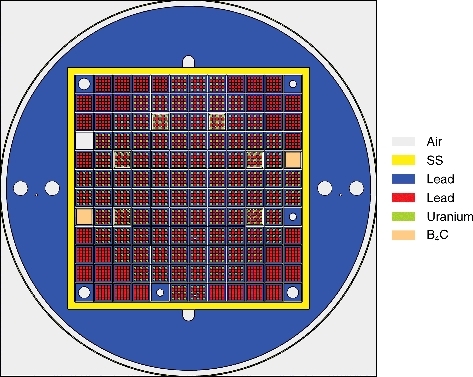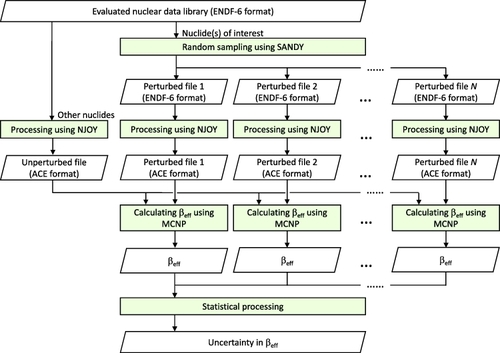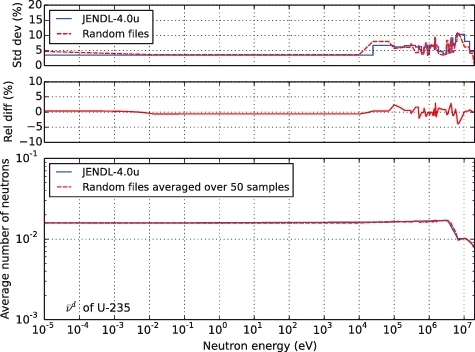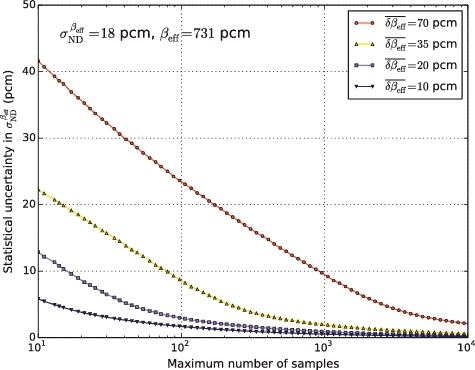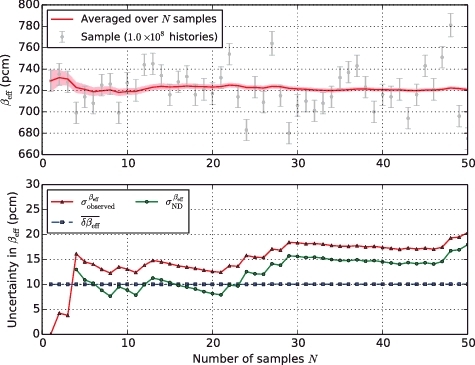 ?Mathematical formulae have been encoded as MathML and are displayed in this HTML version using MathJax in order to improve their display. Uncheck the box to turn MathJax off. This feature requires Javascript. Click on a formula to zoom.
?Mathematical formulae have been encoded as MathML and are displayed in this HTML version using MathJax in order to improve their display. Uncheck the box to turn MathJax off. This feature requires Javascript. Click on a formula to zoom.ABSTRACT
The applicability of Monte Carlo techniques, namely the Monte Carlo sensitivity method and the random-sampling method, for uncertainty quantification of the effective delayed neutron fraction βeff is investigated using the continuous-energy Monte Carlo transport code, MCNP, from the perspective of statistical convergence issues. This study focuses on the nuclear data as one of the major sources of βeff uncertainty. For validation of the calculated βeff, a critical configuration of the VENUS-F zero-power reactor was used. It is demonstrated that Chiba's modified k-ratio method is superior to Bretscher's prompt k-ratio method in terms of reducing the statistical uncertainty in calculating not only βeff but also its sensitivities and the uncertainty due to nuclear data. From this result and a comparison of uncertainties obtained by the Monte Carlo sensitivity method and the random-sampling method, it is shown that the Monte Carlo sensitivity method using Chiba's modified k-ratio method is the most practical for uncertainty quantification of βeff. Finally, total βeff uncertainty due to nuclear data for the VENUS-F critical configuration is determined to be approximately 2.7% with JENDL-4.0u, which is dominated by the delayed neutron yield of 235U.
1. Introduction
The effective delayed neutron fraction βeff performs a key role in reactor design and safety analysis. For a reliable evaluation of the design parameters related to βeff including control-rod worth and the margin of prompt criticality, it is necessary to conduct the uncertainty quantification (UQ) of βeff.
Recently, continuous-energy Monte Carlo transport codes such as the Monte Carlo N-Particle transport code (MCNP) [Citation1] have been identified as powerful tools in calculating not only the effective neutron multiplication factor keff but also its nuclear data sensitivities and kinetic parameters such as βeff (without any geometric modeling approximation). Although these codes do not have the capability to directly calculate the sensitivity of βeff due to their technical shortcomings, the sensitivity of βeff can be expressed approximately as a function of two different keff sensitivities; this means that the uncertainty in βeff due to nuclear data can be quantified by the Monte Carlo sensitivity method using the approximate βeff sensitivities and evaluated covariance data of the nuclear data library, as proposed by Chiba et al. [Citation2]. In addition, a random-sampling-based approach known as the random-sampling method has also attracted significant interest and has been studied extensively in recent years [Citation3–5]; this approach directly calculates the propagation of evaluated nuclear data and/or model parameter uncertainties without the need for the sensitivities. However, when both of these techniques are applied with the Monte Carlo transport code, they inevitably involve statistical uncertainty and therefore require a long computation time to reduce it; because of βeff's numerical complexity, this problem is more prominent for βeff than for keff. Therefore, the βeff UQ using the Monte Carlo method is yet to be attempted.
In this study, the applicability of the two Monte Carlo techniques, the Monte Carlo sensitivity method and the random-sampling method, to the UQ of βeff were investigated from the statistical convergence perspective. In this study, we have dealt exclusively with the nuclear data although various uncertainties (for example, nuclear data, material compositions, geometry, and the computational method) would each affect the calculation of βeff. For the Monte Carlo sensitivity method, we focused on two methods for calculating the βeff sensitivities: (1) Bretscher's prompt k-ratio method [Citation6], a conventional method used to calculate βeff in the Monte Carlo analysis, and (2) the modified k-ratio method which was proposed by Chiba [Citation7]. The theoretical basis for the prompt k-ratio method can be found in the studies of Meulekamp and Van der Marck [Citation8], and the theoretical basis for the modified k-ratio method can be found in the studies of Chiba [Citation7] and Nagaya and Mori [Citation9]. βeff and its sensitivities to the nuclear data were calculated by the MCNP version 6.1.1. For validation of the calculated βeff, we employed a critical configuration of the VENUS-F zero-power reactor at the SCK•CEN site [Citation10], an experimental fast reactor fueled with 30 wt.% enriched metallic uranium and reflected by pure solid lead. In this study, the core geometry was modeled precisely based on small details, and JENDL-4.0u [Citation11,Citation12] was used as the nuclear data library because it contains the covariance data of the delayed neutron yield although there are no covariances for the delayed neutron spectrum χd.
This paper is organized as follows. Section 2 is devoted to the Monte Carlo sensitivity method, where explanations of the two methods, Bretscher's prompt k-ratio method and Chiba's modified k-ratio method, are provided along with the VENUS-F MCNP model, and the UQ through the use of the Monte Carlo sensitivity method. Next, the calculated βeff and their sensitivities and uncertainties are discussed in terms of the statistical issues. Section 3 is devoted to the random-sampling method. In this study, randomly perturbed nuclear data files were produced with the random-sampling code SANDY [Citation5]. Therefore, initially, we describe the process of random sampling by SANDY; then its applicability to the UQ of βeff is examined; finally, our conclusions are presented in Section 4.
2. Monte Carlo sensitivity method
2.1. The βeff sensitivities
2.1.1. Prompt k-ratio method
Bretscher's prompt k-ratio method (which from now on will be referred to as the conventional method) describes βeff as (1)
(1) where k is the effective neutron multiplication factor calculated in the usual way with the Monte Carlo transport code. This is obtained by solving the neutron transport equation:
(2)
(2) where ψ( = ψ(r, Ω, E)) is the angular neutron flux at position r with direction Ω and energy E. The operators
,
, and
represent the transport, scattering, and fission operator, respectively, which are expressed as
(3)
(3)
(4)
(4)
(5)
(5) where Σt and Σs are the macroscopic total and scattering cross sections, respectively; χ,
, and Σf are the fission neutron spectrum, the fission neutron yield, and the macroscopic fission cross section, respectively, each of which is totaled with respect to fissionable materials. In Equation (Equation1
(1)
(1) ), kp is the effective neutron multiplication factor induced by prompt neutrons; which is obtained by solving the following equation:
(6)
(6) where ψp is an angular neutron flux induced by the prompt neutrons;
is a fission (by prompt neutrons) operator expressed as follows:
(7)
(7) In Equation (Equation7
(7)
(7) ), χ
p
and
are the prompt neutron spectrum and the prompt neutron yield, respectively. In the MCNP calculation, kp is obtained with the TOTNU card, an input card which is used to determine if the delayed neutrons are considered in the criticality calculation. The statistical uncertainty of βeff defined in Equation (Equation1
(1)
(1) ) is expressed as
(8)
(8) where the notation δ stands for the absolute statistical uncertainty in a particular parameter. Namely, δk and δkp are the statistical uncertainties in k and kp, respectively; the values of both δk and δkp are calculated by MCNP. Although the propagated statistical uncertainties should ideally include correlations between the variables, for the sake of simplicity, they were disregarded throughout this study. Using the definition of the sensitivity and Equation (Equation1
(1)
(1) ), the sensitivity of βeff to parameter x can be written as follows:
(9)
(9) where Skx( ≡ (∂k/∂x)/(x/k)) and Skpx( ≡ (∂kp/∂x)/(x/kp)) are the sensitivities of k and kp to the parameter x, respectively; these are obtained with the KSEN card of MCNP, a card dedicated to calculating the keff sensitivities. The statistical uncertainty in Sβeffx is expressed as follows:
(10)
(10) where δSkx and δSkpx are statistical uncertainties in Skx and Skpx, respectively; these are also obtained with MCNP.
2.1.2. Modified k-ratio method
Chiba's modified k-ratio method (which from now on will be referred to as the modified method) determines βeff as follows: (11)
(11) where a is a scaling factor introduced by Chiba;
is the effective neutron multiplication factor obtained by solving the following equation:
(12)
(12) where
is a fictitious angular neutron flux obtained from Equation (Equation12
(12)
(12) );
is a fission operator defined as
(13)
(13) Using the relationship between prompt, delayed, and total neutrons:
(14)
(14) Equation (Equation13
(13)
(13) ) can be rewritten as
(15)
(15) In the MCNP calculation,
is obtained using a nuclear data library in which
is multiplied with (a + 1). As a approaches zero, the limit of the right-hand side of Equation (Equation11
(11)
(11) ) equals the exact βeff value [Citation9]; in other words, the approximation in Equation (Equation11
(11)
(11) ) is poorer when a departs from zero. In addition, setting a = −1 in Equation (Equation15
(15)
(15) ) and in Equation (Equation11
(11)
(11) ) turns Equation (Equation11
(11)
(11) ) into Equation (Equation1
(1)
(1) ); to summarize, we see that the conventional method is a special case (a = −1) of the modified k-ratio method. Using Equation (Equation11
(11)
(11) ), the statistical uncertainty in βeff is expressed as follows:
(16)
(16) It can be seen from Equations (Equation8
(8)
(8) ) and (Equation16
(16)
(16) ) that, if the statistical uncertainties in k, kp, and
are similar, the statistical uncertainty in βeff calculated using the modified method is |a| times smaller than that derived using the conventional method. Using the definition of the sensitivity and Equation (Equation11
(11)
(11) ), the βeff sensitivity to the parameter x is expressed as follows:
(17)
(17) where
is the sensitivity of
to the parameter x. The statistical uncertainty in Sβeffx is expressed as
(18)
(18) By comparing Equation (Equation9
(9)
(9) ) with Equation (Equation17
(17)
(17) ), and Equation (Equation10
(10)
(10) ) with Equation (Equation18
(18)
(18) ), we conclude that the expressions for the sensitivity and its statistical uncertainty calculated using the modified method are similar to those calculated using the conventional method.
2.1.3. Calculation procedure
The βeff value and its sensitivities were obtained from k, , and kp and their sensitivities computed by the KSEN card. The calculation procedure of
is as follows. The values of
of the VENUS-F fissionable materials (i.e. 235U and 238U) stored, according to ENDF-6 format rules [Citation13], in a section MT=455 of a file MT=1, were multiplied with (a + 1). The values of
(MF = 1, MT = 452) as the sum of
(MF = 1, MT = 456) and
was adjusted accordingly. The alternated nuclear data files for 235U and 238U were processed into the ACE format (a pointwise-nuclear-data format for MCNP) using the nuclear data processing code NJOY [Citation14]. Using these ACE-formatted files, the
value and its sensitivities were calculated using MCNP.
2.2. The βeff uncertainties
Using the sensitivity profile obtained by the two different methods, the βeff uncertainty (standard deviation) due to nuclear data was evaluated for each method by the uncertainty propagation law, which is expressed as (19)
(19) where cov(x, g; x′, g′) denotes a (g, g′; x, x′) component of variance–covariance matrix (g, g′: energy group, x, x′: reaction), which was obtained by processing covariance data stored in JENDL-4.0u with NJOY and ERRORJ [Citation15]. In this analysis, we employed eight parameters: fission, neutron capture, elastic scattering, inelastic scattering, and (n, 2n) reaction cross sections, prompt and delayed neutron yields, and prompt neutron spectra for seven major constituent materials: 235U, 238U, 56Fe, 204Pb, 206Pb, 207Pb, and 208Pb. Correlations between the reactions were also taken into account. Even though Kodeli [Citation16] proposed that the contribution of χ
d
to the βeff uncertainty should not be disregarded, we did not include this parameter due to the absence of its covariance data in JENDL-4.0u. The statistical uncertainty in
for parameter x is expressed as
(20)
(20)
2.3. VENUS-F MCNP model
The MCNP model of the zero-power VENUS-F critical core used in the βeff measurement [Citation17] is illustrated in . The core consists of a cylindrical vessel filled with pure solid lead reflector and a 12 × 12 square grid where fuel and lead assemblies as well as safety and control rods are loaded longitudinally. The fuel assembly has a 5 × 5 lattice structure piled up with lead blocks and fuel rodlets made of 30 wt.% metallic uranium. The detailed design of the VENUS-F core is provided by Fridman et al. [Citation18].
2.4. Results and discussions
2.4.1. Effective delayed neutron fraction
shows the calculated k and kp, and with different scaling factors (a = 1, 2, 5, 10, 15, and 20), which include 1σ statistical uncertainties. For each case, the keff value was calculated with 1.0 × 108 histories (1.0 × 105 source histories per cycle times 103 cycles), that resulted in the statistical uncertainty of ∼7 pcm. shows a comparison of the calculated βeff and C/E values for these different scaling factors. The experimental βeff value was estimated to be 730 ± 11 pcm using neutron noise techniques [Citation17,Citation18]. The value calculated directly using the adjoint weighting function [Citation19] (from now on referred to as the direct method) for the same number of histories was 731 ± 10 pcm. On first inspection, the direct method appears to agree well with the experimental data; however, the statistical uncertainty is rather too large. In contrast, as expected from Equation (Equation16
(16)
(16) ), the statistical uncertainty calculated by the modified method decreases with increase in a; which is about |a| times smaller than that derived using the conventional method. It was also observed that, with increase in a, the calculated βeff values decreased and the agreement worsened. A similar trend can be seen in the benchmark results for fast neutron systems conducted by Chiba [Citation7] using a deterministic transport code CBG [Citation20]; this is linked to a limitation in the approximation of Equation (Equation11
(11)
(11) ).
Figure 2. Comparison of calculated βeff (lower) and C/E (upper) values with different scaling factors. In the lower panel, the band with pale color and the error bars indicate 1σ experimental uncertainty and 1σ statistical uncertainty, respectively; in the upper panel, the error bars indicate 1σ uncertainty considering both experimental and calculational uncertainties.
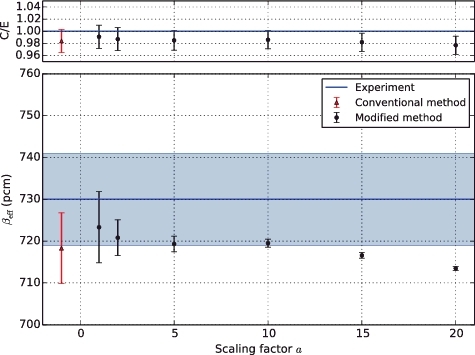
Table 1. Calculated k, , and kp with 1σ statistical uncertainties
2.4.2. Sensitivity profile
and show profiles of the βeff sensitivities with respect to 238U and 235U reaction parameters, respectively, with the 70-energy-group structure calculated using the conventional method. As supposed in Chiba et al. [Citation2], the statistical uncertainty is very large for all reaction parameters except for ; this is a result of the small difference between Skpx and Skx. On the contrary, the statistical uncertainty for
is negligible because
and
are each zero in Equations (Equation9
(9)
(9) ) and (Equation10
(10)
(10) ), respectively.
Figure 3. Sensitivity profile of 238U for βeff calculated by the conventional method. The pale color around the line indicates 1σ statistical uncertainty.
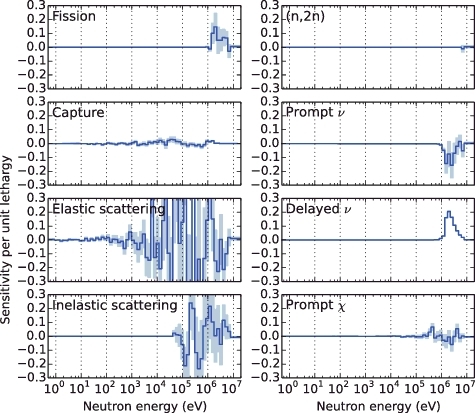
Figure 4. Sensitivity profile of 235U for βeff calculated by the conventional method. The pale color around the line indicates 1σ statistical uncertainty.
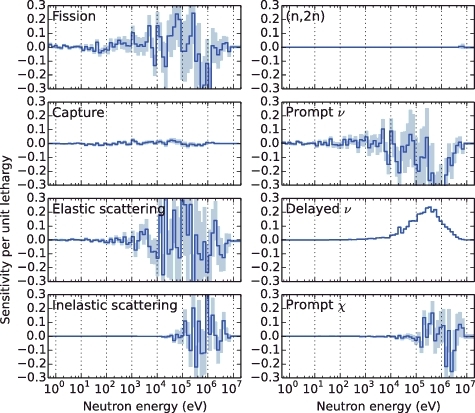
As examples of the sensitivity profiles calculated by the modified method, a comparison of the βeff sensitivity profiles of 235U elastic scattering and with different scaling factors is shown in . It is observed that the βeff sensitivities converge and that their statistical uncertainties decrease with increase in a. By comparing with the trend of the βeff values to a in , it follows that the βeff sensitivities change within their own 1σ statistical uncertainties, while the nominal values of βeff tend to exceed their 1σ statistical uncertainties. This indicates that the influence of the change in the βeff sensitivities that results from increasing a on the UQ of βeff is expected to be small, while the approximation of Equation (Equation11
(11)
(11) ) worsens. Although these statistical uncertainties can be reduced using the conventional method by simply increasing the number of source histories, an unacceptably large number of source histories or an excessive amount of computing time would be needed to achieve acceptably small statistical uncertainties. For example, illustrates the sensitivity profile of 235U for βeff; this is the same as but calculated by increasing the number of source histories by a factor of 3 (3 × 108 histories). In this case, the total elapsed time resulted in 41 days. Therefore, although the number of source histories was increased to an almost acceptable limit, taking into consideration the computing time and storage capacity, the statistical uncertainty remained large.
Figure 5. Comparisons of sensitivity profile of 235U elastic scattering (left) and (right) for βeff with different scaling factors. The pale color around the line indicates 1σ statistical uncertainty.
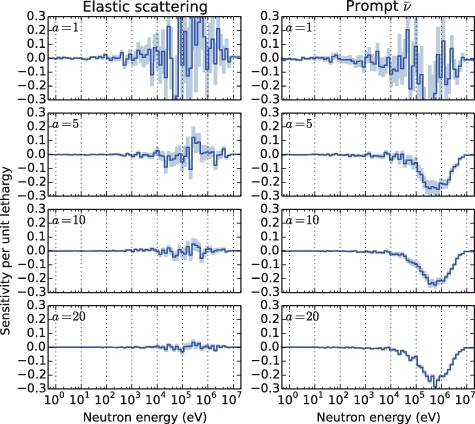
Figure 6. Sensitivity profile of 235U for βeff calculated by the conventional method with 3 × 108 histories. The pale color around the line indicates 1σ statistical uncertainty.
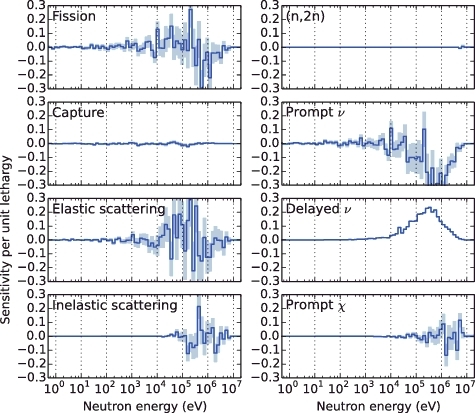
Figure 7. Comparison of calculated nuclide-wise contributions to βeff uncertainty with different scaling factors. The error bars indicate 1σ statistical uncertainty.

Figure 8. Comparison of calculated reaction-wise contributions to uncertainty in βeff between the conventional method (upper) and the modified method (lower). The error bars indicate 1σ statistical uncertainty.
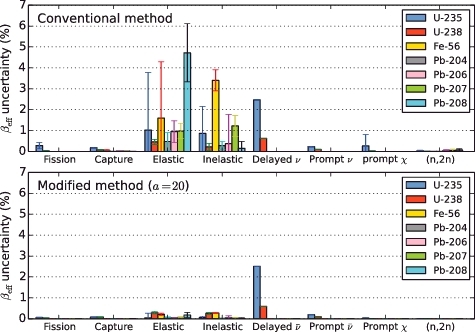
2.4.3. Uncertainty due to nuclear data
The βeff uncertainties, caused by nuclear data, between the conventional method and the modified method using different scaling factors are summarized in ; their nuclide-wise contributions are shown in . It can be seen that the conventional method and the modified method with small scaling factors tend to estimate both uncertainty values and their statistical uncertainties to be larger than that calculated by the modified method with large scaling factors. This arises due to the large sensitivities with large statistical uncertainties in the sensitivity profile as previously described; these statistical uncertainties can be reduced by increasing a and appear to be sufficiently small at a = 20. In addition, shows that, as a increases, the calculated total βeff uncertainty approaches a value of 2.7%.
Table 2. Comparison of calculated βeff uncertainty, caused by nuclear data, between the conventional method and the modified method with different scaling factors
shows a reaction-wise breakdown of the βeff uncertainties due to nuclear data calculated by the conventional and modified methods (at a = 20). For the same reason as explained previously, the contributions of the scattering cross sections and their statistical uncertainties were reduced by increasing the scaling factor. This indicates that the contribution of the scattering cross sections to the total uncertainty should not be too significant. Although there are no ways to experimentally validate uncertainty in βeff, we concluded that, for the VENUS-F critical configuration, the total βeff uncertainty due to nuclear data yielded ∼2.7% in relative value (∼22 pcm in absolute value) which is dominated by of 235U (∼18 pcm) followed by that of 238U (∼4 pcm).
3. Random-sampling method
3.1. Calculation procedure
3.1.1. Calculation flow
As mentioned earlier, the uncertainty due to nuclear data was estimated using SANDY. Details of its theoretical methodology and verification can be found in the studies of Fiorito et al. [Citation5]. Since considerable computing time is involved, in this study, we have focused only on the of 235U, which was the major contributor to the βeff uncertainty predicted by the Monte Carlo sensitivity method. illustrates a schematic block diagram of UQ with the random-sampling method. First, N pointwise random files, in which reaction parameters were normally distributed in accordance with the evaluated covariance data, were produced by SANDY from JENDL-4.0u. As an example of the files produced, a comparison of
of 235U between the random files and JENDL-4.0u is presented in . Note that the
of 235U is also modified according to the summation rule, MT452 = MT455 + MT456. The files were subsequently processed into the ACE format with NJOY, and N MCNP runs were carried out using these ACE-formatted files. The βeff and its statistical uncertainty δβeff were obtained using the direct method. Finally, reaction-wise uncertainties due to nuclear data were quantified by conducting statistical processing using the resultant βeff values with their statistical uncertainties.
3.1.2. Statistical processing
The statistical processing procedure adopted is as follows. Assuming that MCNP computes δβeff properly and accurately, the uncertainty due to nuclear data σβeffND can be obtained from the following equation: (21)
(21) where σβeffobserved is the observed statistical uncertainty in βeff obtained from N times MCNP runs with the random files;
indicates δβeff averaged over N samples.
In this study, to determine the number of source histories per sample ns and the total number of samples Ntotal beforehand, a simple Monte Carlo simulation was conducted, and the statistical uncertainty in the βeff uncertainty due to nuclear data was deduced from the simulation result, whose methodology is as follows. First, βeff was distributed normally with mean μ and variance σ2:
(22)
(22)
For μ, we chose the value of 731 pcm, which was estimated by the direct method as described earlier. The variance σ2 was defined as (23)
(23) where
is the βeff uncertainty due to nuclear data with respect to
of 235U, for which the value of 18 pcm estimated by the Monte Carlo sensitivity method was used. In this case, the
, the average statistical uncertainty in βeff as defined previously, is a variable used to determine
and Ntotal. Next,
and its statistical uncertainty
were estimated conversely from the distributed βeff values by statistical processing over a large number of trials. shows
as a function of
and Ntotal simulated for 40,000 trials. As anticipated, with decrease in
and/or increase in Ntotal,
decreases. For example, if
is as large as 70 pcm, an unacceptable number of samples (>104) is required to obtain a reliable
. From this figure and by compromising on the computing resources and time spent, we chose Ntotal = 50 and ns = 1.0 × 108 (1.0 × 105 source histories per cycle times 103 cycles) in which each resultant δβeff value was almost 10 pcm. In this case,
was expected to be 2 pcm.
3.2. Results and discussions
shows the convergence of βeff and its uncertainty with respect to of 235U, where the βeff value averaged over Ntotal( = 50) and the
value at Ntotal were 721 and 18 pcm, respectively. From the Monte Carlo simulation as outlined earlier (with μ = 721 pcm,
pcm, and
pcm as the input parameters), the statistical uncertainty was estimated to be 2 pcm.
provides a comparison of the calculation results between the Monte Carlo sensitivity method and the random-sampling method. It can be seen that the difference between the two results is within the 1σ uncertainty. The total number of histories shown in demonstrates that the random-sampling method is much slower than the Monte Carlo sensitivity method in estimating the uncertainty due to nuclear data. In addition, despite the large number of trials or source histories, the random-sampling method still involves larger statistical uncertainties than the Monte Carlo sensitivity method. Although the random-sampling method has the advantage of not needing to compute the sensitivities, these results indicate that this method currently has a limitation attributable to the use of UQ of βeff.
Table 3. Comparison of βeff uncertainty and its statistical uncertainty with respect to of 235U and the total number of source histories used
4. Conclusions
We investigated the applicability of the two types of Monte Carlo techniques, the Monte Carlo sensitivity method and the random-sampling method, in the UQ of βeff from the prospective of statistical convergence issues. For the Monte Carlo sensitivity method, we demonstrated that Chiba's modified k-ratio method is superior to Bretscher's prompt k-ratio method in terms of reducing the statistical uncertainty in calculating not only βeff but also its sensitivities and uncertainty due to nuclear data. Although the approximation of βeff in the modified method becomes poorer as a increases, it was revealed that the βeff sensitivities are more stable with respect to the a change than the nominal βeff values. In addition, it was shown that the random-sampling method agrees with the Monte Carlo sensitivity method for the of 235U; it was also shown that the Monte Carlo sensitivity method is more practical for the UQ of βeff in terms of reducing the statistical uncertainty and reducing computing time. Finally, we demonstrated that the total βeff uncertainty for the VENUS-F critical configuration is approximately 2.7%, and that it is dominated by the
of 235U. It is noted that the impact of the χd uncertainty was not estimated because of the lack of covariance data in JENDL-4.0. For more reliable UQ of βeff, covariance data evaluation of χd is required.
Acknowledgments
The authors are grateful to Drs K. Nishihara and T. Sugawara of the Japan Atomic Energy Agency (JAEA) and Prof. G. Chiba of Hokkaido University for providing useful comments and suggestions. One of the authors (H. Iwamoto) would like to thank Dr S. Meigo of JAEA for encouraging his work at SCK•CEN.
Disclosure statement
No potential conflict of interest was reported by the authors.
References
- Goorley JT. MCNP6.1.1-Beta release notes. Los Alamos (NM): Los Alamos National Laboratory; 2014. ( Los Alamos Reports; no. LA-UR-14-24680).
- Chiba G, Tsuji M, Sugiyama K, et al. JENDL-4.0 benchmarking for effective delayed neutron fraction of fast neutron systems. J Nucl Sci Technol. 2011;48(12):1471–1477.
- Rochman D, Koning AJ, Van der Marck SC, et al. Nuclear data uncertainty propagation: Perturbation vs. Monte Carlo. Ann Nucl Energy. 2011;38(5):949–952.
- Yamamoto A, Kinoshita K, Watanabe T, et al. Uncertainty quantification of LWR core characteristics using random sampling method. Nucl Sci Eng. 2015;81:160–174.
- Fiorito L, Zerovnik G, Stankovskiy A, et al. Nuclear data uncertainty propagation to integral responses using SANDY. Ann Nucl Energy. 2017;101:359–366.
- Bretscher MM. Evaluation of reactor kinetic parameters without the need for perturbation codes. Proceedings of the 1997 International Meeting on Reduced Enrichment for Research and Test Reactors; 1997 Oct 5–10; Jackson Hole (WY); 1997.
- Chiba G. Calculation of effective delayed neutron fraction using a modified k-ratio method. J Nucl Sci Technol. 2009;46(5):399–402.
- Meulekamp RK, Van der Marck SC. Calculating the effective delayed neutron fraction with Monte Carlo. Nucl Sci Eng. 2006;152:142–148.
- Nagaya Y, Mori T. Calculation of effective delayed neutron fraction with Monte Carlo perturbation techniques. Ann Nucl Energy. 2011;38:254–960.
- Baeten P, Abderrahim HA, Bergmans G et al, . The GUINEVERE project at the VENUS facility. Proceedings of the International Conference on the Physics of Reactors 2008 (PHYSOR 2008); 2008 Sep 14–19; Interlaken (Switzerland): Paul Scherrer Institute; 2008.
- Shibata K, Iwamoto O, Nakagawa T, et al. JENDL-4.0: a new library for nuclear science and engineering. J Nucl Sci Technol. 2011;48(1):1–30.
- Iwamoto O, Nakagawa T, Chiba S, et al. Covariance evaluation for actinide nuclear data in JENDL-4. J Korean Phys Soc. 2011;59(2):1224–1229.
- Trkov A, Herman M, Brown DA. ENDF-6 formats manual. New York (NY): Brookhaven National Laboratory; 2012. ( CSEWG Document ENDF-102 Report; no. BNL-90365-2009 Rev.2 SVN Commit: Revision 85).
- MacFarlane RE, Muir DW, Boicourt RM, et al. The NJOY nuclear data processing system. Version 2012. Los Alamos (NM): Los Alamos National Laboratory; 2017. ( Los Alamos Reports; no. LA-UR-12-2079 Rev).
- Chiba G. ERRORJ – a code to process neutron-induced reaction cross section covariance, Version 2.3. Tokai: Japan Atomic Energy Agency; 2007. ( JAEA Reports; no. JAEA-Data/Code 2007-007).
- Kodeli I. Sensitivity and uncertainty in the effective delayed neutron fraction (βeff). Nucl Instrum Methods Phys Res A. 2013;715:70–78.
- Doligez X, Billebaud A, Chabod S et al. Effective delayed neutron fraction measurement in the critical VENUS-F reactor using noise techniques. Proceedings of the 2015 4th International Conference on Advancements in Nuclear Instrumentation Measurement Methods and their Applications (ANIMMA 2015); 2015 Apr 20–24; Lisbon (Portugal); 2016.
- Fridman E, Kochetkov A, Krása A. Modeling of FREYA fast critical experiments with the Serpant Monte Carlo code. Ann Nucl Energy. 2017;108:239–252.
- Kiedrowski B, Brown F. Adjoint-weighting for critical systems with continuous energy Monte Carlo. Los Alamos (NM): Los Alamos National Laboratory; 2009. ( Los Alamos Reports; no. LA-UR-09-02594).
- Chiba G. Calculations of Kobayashi benchmark problems with a neutron transport simulation code system CBG. Tokai: Japan Atomic Energy Agency; 2009. ( JAEA Reports; no. JAEA-Research 2009-012). Japanese.

